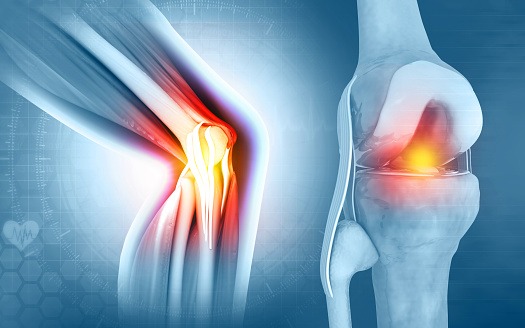If it sounds too good to be true, we’re supposed to believe it’s total hogwash. Plus, I’m a skeptic in general of big claims…but when it comes to runner’s knee, I’m absolutely not yanking your chain this works.
I’ve found a process to help most us of figure out the root cause of why our knees hurt after running and fix it.
Of course, there are a million ways to get injured, but I do my best to show you how to prevent them.
Runner’s Knee Pain
Unfortunately, it’s a common issue which leads people to believe that running is bad for your knees.
It’s not. Many doctors and studies agree that it’s not and it can help provide joint strength and lubrication.
So what gives? Well….our desire to spend all our time running and not always looking at the other ways we need to strengthen our body for total health.
Everyone kept telling me I just needed to rest my knee.
I knew intrinsically that something else was going on, I just couldn’t for the life of me figure out what the heck it was!!!
So I kept digging and finally, put it all together.
I followed the tips outlined below and was running pain free again within just a couple of weeks!
So yes, I believe in these tools.
Let’s break this down into the key components.
Runner’s knee recovery time can be extensive, but that’s usually because we aren’t putting all the components together.
What to do to fix runner’s knee?
- Fix hip alignment
- Fix knee extension
- Fix any knee drift
- Fix weak hip, glutes, core
- Fix any bad running form issues
- Don’t just rest and expect healing
So if you really want to know how to cure runner’s knee, keep reading and then TAKE ACTION.
1. Hip Alignment for Runners
Hip alignment refers to the idea that your pelvis should be level from side to side and not rotated forward or backwards.
Due to the constant pounding of running, it is not uncommon for runners to find their hips get out of whack….what resolves that is first the chiropractor and then all the hip, glute and core work I’m going to mention below.
Here’s a test you can do to check hip alignment at home.
My right leg is shorter and I’ve heard this from many chiro’s, so we agreed that was probably not an issue since I’ve been running just fine with it for many, many years.
- Yes, you can run pain free with one leg shorter
- If you’ve always done it without issue and didn’t even know it existed, it’s fine
- BUT if this is a new shift in your pelvis that could be causing issues
2. Improve Knee Extension
This move from Kelly Starrett worked the first time I tried it. (It may not be necessary for YOU, so test it out and see if you notice a change.)
All these doctors and not a darn one of them recommended or even looked at this, which makes me crazy!!!
For months I kept telling Sheena it seemed really bizarre to me that I could move my right leg in to hyper-extension, but had 0 extension with my left leg.
Check out this video clip.
https://youtu.be/2ENgwxb4zFA
I didn’t know what to call it or why it mattered since when I pointed it out to the PT they all just said, hmm that’s weird.
The acupuncture guy said tight IT Band, but even I knew that didn’t make sense. So I researched the best method and found that the popliteus muscle needed to be stretched.
Here’s another video with moves and an explanation of the muscle. https://www.youtube.com/embed/8Lf4pWmPsB8
Which led me to “terminal knee extension” and immediately I knew I was heading in the right direction because it finally described what I felt.
I recognized that this issue is probably not one most of you have, but in case someone else out there is suffering this way I had to share it.
I did this and a couple of others and regained complete range of motion…that’s right with no answers and in a few short weeks almost back to normal just doing something for free at home!
3. Fix Knee Pain by Resolving Knee Drift
After talking with a stellar physical therapist, we agreed that my hips are pretty much always a little off even after adjustment.
Then looking down at my foot said, “look how your foot is falling inward while you simply stand still”.
What’s called knee valgus, is particularly common in female runners, due to what’s known as the Q-angle from wider hips. But I had this misalignment which resulted in more common issues with the runner’s knee, IT Band pain, and ankles, this meant that I needed to do the right strength work.
The knee drift could be caused by foot pronation, weak hips or misaligned hips.
- Start with hip and glute strength BEFORE adding a running insole to your shoe
- Don’t think it’s something you have to live with, running should not be painful.
Best running shoes for knee pain?
When I switched to the Brook’s Brand around 2017 they seemed to resolve my IT Band pain, so I stuck with them for many years.
But it’s highly logical that after many more years of running some things have changed in my body and my stride. YES, you may need a different shoe now than you used to!!
- Lower profiles shoes tend to help prevent overstriding and heel striking and as noted seem to help IT Band issues (low profile means a low heel-to-toe drop, not always a minimal shoe)
- Rotate your running shoes to work different muscles and prevent reliance on a shoe to fix a weakness
- Zero drop shoes do not guarantee any knee pain if you have a poor form (checkout what matters in a gait analysis)
- Stability shoes often hide your weak hips and glutes, so as noted do the work before moving to a shoe that corrects your foot
- Finally, it’s time to look at orthotics when you’ve done the core strength and noticed you need just a little more help (especially if running with flat fee). I like insoles because you can still get a neutral shoe and it’s a smaller adjustment many times than a firmer stability shoe.
4. Fix Knee Pain with Total Core Strength
Core doesn’t just mean abs, it means glutes and hips too. All together they provide the stability you need to prevent knee, ankle, hip and IT Band pain from running.
You don’t have to go to a PT, as I do share tons of moves here on Running Professor…but it’s never bad to get someone to evaluate your movement patterns.
Once I realized that I needed to first do the knee extension stretch, next was learning to reactivate the glute medius and external rotators.
Squats and lunges are going to work the glute maximus, but you need to activate other muscles for complete hip stability.
Ready for IMMEDIATE HELP? Checkout this 30 Day Core Runner Program, which is 10 minutes a day of follow along videos to help your runner’s knee and IT Band.
Here are some additional movements, you can start doing right now to help fix your running knee pain.
https://www.youtube.com/embed/KbOVWfnYiG0
I can also tell you since having two motorcycle injuries, my PT recommended surgery, my focus was on core strength (walking competitions) this is what helped me to recover along with daily flexibility training i.e. standing against a wall and pulling your foot heel up to your cheek…it hurt like crazy, but it got me back to running and eventually after six months a higher mileage faster than normal.
5. Running Form for Knee Pain
While strength issues are often the primary driver of knee pain while running, there are some stride issues that could be culprits as well.
- Your foot should land under your body, if it’s in front you are heel striking which causing a braking effect and sends a lot of pressure up to the knee
- If you are running on the balls of your feet and overtaxing the calf muscles they could be pulling on your knee and IT Band
- If you are swing your arms across your body that causes your hips to twist and that radiates down the leg to your knees
6. Rest isn’t the answer
If you are experiencing sharp shooting pains, then 100% you MUST stop running.
But just not running isn’t going to resolve runner’s knee.
- You must figure out if your body is out of alignment
- You must work on overly tight muscles
- You must add in the lacking strength (trust me every runner could do more)
- Take joint health for runners seriously
One idea is Manual Muscle Manipulation. Tight muscles pull your body out of alignment and your knees often taken the brunt of that!
Beyond just seeing a PT to figure out your alignment, they can also work more deeply with your muscles.
This could mean, a deep tissue massage, dry needling, or even electric stem; you have to experiment to find out what works best for you.
I found that daily foam rolling, combined with a monthly massage is one of the best ways to prevent running knee pain.
I hope this was helpful to anyone having issues, I know how frustrating it can be to try and find answers!
Please do share with your running friends, I want us all to figure out what works for us individually to stay running as long and healthy as we can.
Checkout the Ultimate IT Band Solution >>
The moral of the story, you know your body…keep looking for answers.
Have you ever realized your favorite shoe might not be best for you anymore?
Theories and Solutions for Patellar Tendonitis, Jumpers Knee, and Patellar Tracking Problems. Designed to fix those who have knee pain when running, jumping, and squatting.
Must-Have Gear
Running Jackets for Every Condition
FITNESS PARTNERS
Please note that affiliate links {such as Amazon} may pop up on RP from time to time. They do not cost you anything to use, but are a huge help to support the ongoing content creation process. Click here to do your shopping!
Copyright © 2022 · https://runprofessor.com/ All Rights Reserved
Disclaimer:
This post contains affiliate links which means I may receive a small commission if you purchase using that link at no extra cost to you. and if you do, I appreciate you!




